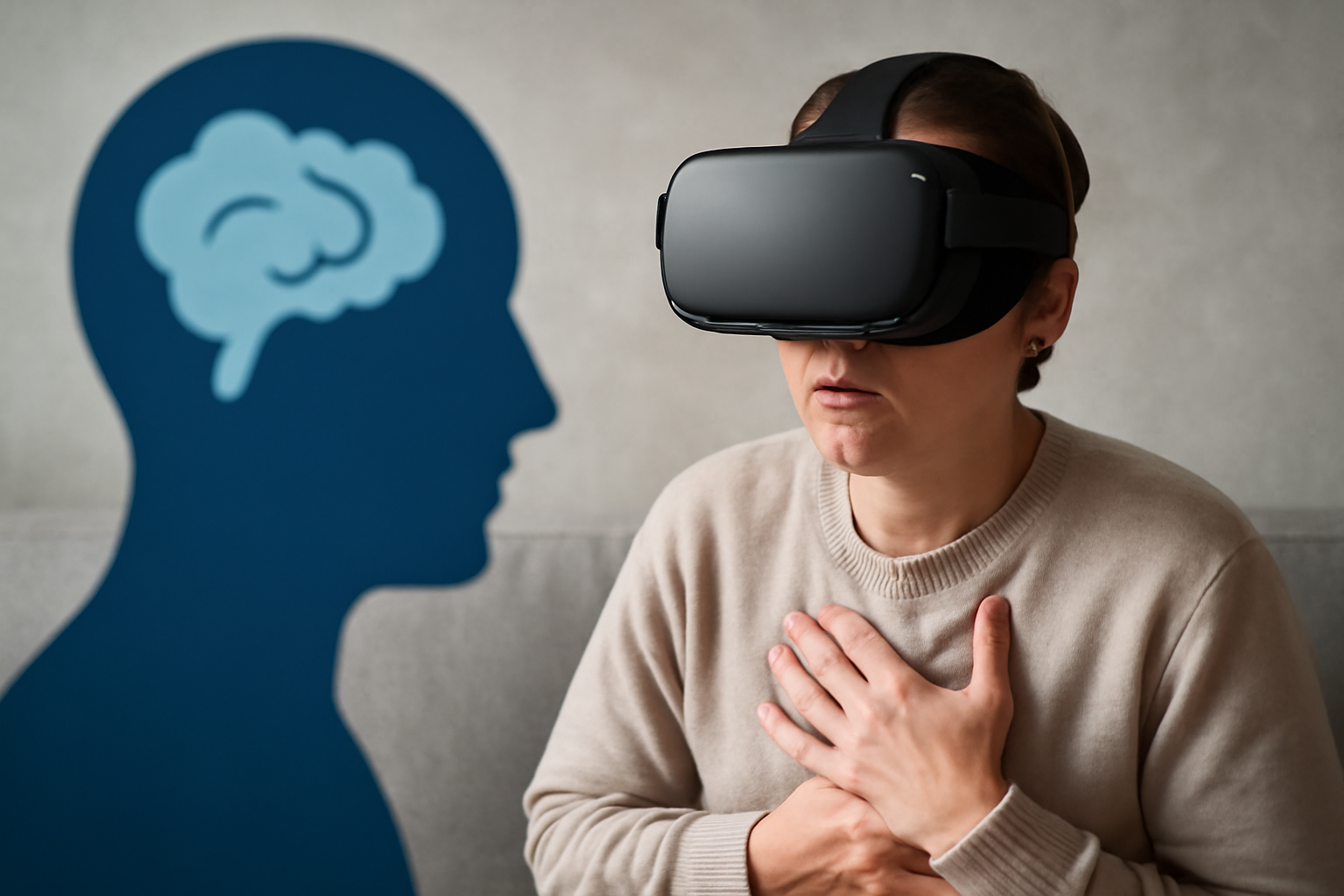Virtual reality therapy combines immersive digital environments with guided therapeutic approaches to help people address fears, reduce distress, and learn new coping skills under professional supervision. Rooted in exposure-based and cognitive-behavioral frameworks, VR therapy uses controlled, graded scenarios to replicate real-life challenges in a safe, adjustable setting.
In practice, therapists tailor scenarios to individual goals, monitor distress in real time, and integrate VR exercises with talk therapy, homework, and ongoing assessment. This approach aims to accelerate learning, improve transfer to daily life, and empower clients to regain control over their thoughts, emotions, and behaviors.
Core principles and techniques used

- Immersion and presence: High-fidelity environments help clients feel present in a safe yet impactful setting, which can enhance engagement and emotional processing.
- Graded exposure and pacing: Scenarios are calibrated to match the client’s readiness, with gradual increases in difficulty to prevent overwhelm while promoting gradual habituation and mastery.
- Personalization and collaboration: Treatment plans are co-created with the client, adjusting intensity, content, and goals as progress unfolds.
- Real-time monitoring and feedback: The therapist observes how the client responds (physiological cues, self-report ratings) and adjusts the session accordingly to maximize learning.
- Multisensory engagement and coping skills: Visual, auditory, and sometimes tactile cues are used alongside techniques such as controlled breathing, grounding, and cognitive strategies to regulate distress.
- Data-driven progress tracking: Objective and subjective measures are collected across sessions to evaluate change and guide next steps.
- Safety, ethics, and privacy: Sessions are conducted with clear consent, informed boundaries, and precautions to protect well-being and data security.
Techniques often used within VR therapy
- VR-based exposure therapy: Clients confront feared situations in a controlled, repeatable way, enabling graded desensitization.
- VR-assisted relaxation and mindfulness: Immersive environments guide relaxation practices and present mindfulness cues in contextually meaningful settings.
- Cognitive restructuring and skills training: The virtual context provides opportunities to practice reframing thoughts, problem-solving, and coping strategies.
- Biofeedback and physiological monitoring: When available, metrics like heart rate or skin conductance help tailor intensity and teach self-regulation.
- Social and performance skills rehearsal: VR simulates social interactions, public-speaking scenarios, or job-related tasks to practice communication and behavior.
- Motor and cognitive rehabilitation: In medical or neurological contexts, VR supports motor planning, coordination, and attention training through engaging tasks.
Conditions and issues VR therapy is most effective for
VR therapy has the strongest and most consistent evidence for several conditions and challenges, with growing but more nuanced support in others. Effectiveness often depends on the match between the client’s goals, the protocol used, and integration with standard care.
- Spiders, heights, flying, needles, and other common phobias respond well to controlled VR exposure.
- VR exposure helps reprocess traumatic memories in a safe context and supports progressive desensitization within a structured treatment plan.
- VR can facilitate gradual exposure to social or performance-related scenarios, reducing avoidance and improving coping skills.
- Distraction, attention modulation, and relaxation in VR can lower perceived pain and anxiety during medical procedures and in ongoing pain management.
- Some programs target social cognition, emotion recognition, and pragmatic communication in a motivating, repeated practice space.
- Post-stroke or brain injury rehabilitation can benefit from VR-supported motor and cognitive exercises in a motivating, engaging format.
- VR cue-exposure approaches are being studied as adjuncts to traditional treatments, with mixed but promising findings in early trials.
What to expect in sessions
Session structures vary by clinician and goal, but most VR therapy encounters share common elements designed to be safe, collaborative, and goal-focused.
- The therapist reviews history, current symptoms, goals, and readiness for VR work. Baseline measures help track change.
- Clients learn how the VR headset, controls, and software work, along with safety guidelines and contingency plans for discomfort.
- A series of virtual scenarios aligned with the treatment plan is conducted, with therapist coaching, prompts, and adjustments as needed.
- After each VR task, there is debriefing to reflect on feelings, insights, and strategies for coping in real life.
- Clients may be assigned between-session practice to reinforce skills and prepare for the next exposure step.
- Cybersickness (nausea, dizziness, eye strain) or distress are monitored, with adjustments to duration, intensity, or duration of sessions as needed.
- Ongoing rating of distress levels, confidence, and functional goals help guide whether to advance, pause, or modify the plan.
The therapeutic process and timeline
A typical VR therapy course blends assessment, skill-building, and exposure across several weeks. Timelines vary by condition severity, goals, and individual response, but the following framework is common:
- Comprehensive evaluation, clarifying goals, and selecting target VR scenarios aligned with one or more therapeutic aims.
- Creating a graded hierarchy of VR situations, with pacing agreed upon by client and clinician.
- Regular sessions—often weekly or biweekly—combining VR exposure with cognitive and coping strategies, plus between-session practice.
- Re-evaluating symptoms, progress toward goals, and whether to intensify, extend, or shift the focus.
- Consolidating skills, planning for real-world application, and scheduling booster sessions if needed.
- When goals are met, the client and clinician agree on a maintenance plan or periodic follow-ups to sustain gains.
In many anxiety- and phobia-focused cases, noticeable improvements can appear within a few weeks, with full completion often occurring over 6–12 weeks. More complex trauma, chronic pain, or neurological rehabilitation may require longer, multidisciplinary collaboration and ongoing support beyond the VR component.
Qualifications to look for in practitioners
- Clinicians such as psychologists (PhD/PsyD), psychiatrists (MD), licensed clinical social workers, or licensed mental health counselors with training in evidence-based therapies (e.g., CBT, exposure therapy) and a supervised background.
- Experience with VR and exposure work: Demonstrated training in VR-based interventions, familiar with safety protocols, and ability to tailor VR content to clinical goals.
- Ethics, privacy, and consent: Clear discussions about data use, privacy protections, consent for VR sessions, and handling of distress during treatment.
- Engagement in ongoing supervision or continuing education related to VR therapy and related technologies.
- Willingness to coordinate with other healthcare providers (physicians, therapists, or rehabilitation specialists) when needed.
Considerations for choosing this approach
- Availability of VR equipment, clinic proximity, scheduling, and the need for in-person sessions versus remote or hybrid formats.
- Out-of-pocket costs, what insurance plans cover, and whether VR sessions are billed as part of broader therapy or as specialized interventions.
- VR therapy is most effective when paired with established treatments and tailored to the individual’s goals and safety needs.
- Some clients experience nausea, dizziness, or emotional discomfort that may influence suitability and pacing.
- Understanding of what data is collected, how it’s stored, and who has access to it; ensuring a private, comfortable space for sessions.
- Personal comfort with technology, openness to VR experiences, and alignment with overall treatment goals and values.
- Whether VR therapy is used as a standalone intervention or integrated with pharmacotherapy, psychotherapy, or rehabilitation services.
⚠️ This content is for informational purposes only and is not a substitute for professional medical advice, diagnosis, or treatment. Always consult a licensed physician, psychiatrist, or other qualified health professional before making decisions about medications or mental health treatment.

